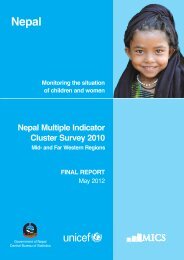Small Area Estimation of Poverty
Small Area Estimation of Poverty
Small Area Estimation of Poverty
- No tags were found...
Create successful ePaper yourself
Turn your PDF publications into a flip-book with our unique Google optimized e-Paper software.
With the previous poverty mapping exercise in 2006, povertyincidence at the ilaka level had been estimated to range between 1%and 82% using the 2001 Population Census (CBS et al., 2006). Thecurrent 2010/11 estimations are <strong>of</strong> similar magnitude, albeit slightlylower in line with steady poverty reduction over the past decade. Wefind poverty incidence levels ranging between 0.5% and 72.8% onthe ilaka level, with an unweighted mean/median <strong>of</strong> 26.9%/25.7%(see table A II 2 in Appendix II (<strong>of</strong> the main document)). Previousilaka-level FGT(0) estimates had an average standard error <strong>of</strong> 0.038,compared to 0.056 now. The 2006 results are likely somewhat moreprecise as they were able to select a consumption model from a muchlarger set <strong>of</strong> common variables; besides the incomparability issuediscusses above, the previous exercise had access to a larger set <strong>of</strong>data. Particularly, agricultural information on the ownership <strong>of</strong>livestock, poultry, agricultural land, and ownership <strong>of</strong> a business wasavailable then, and this information would arguably be a resourcefuladdition to the models underlying our results. In addition, asdiscussed above, the strategy for calculating standard errors takenin this study can be regarded as ‘conservative’ and may also accountfor slightly wider standard errors than the previous poverty mappingexercise.<strong>Poverty</strong> incidence on the level <strong>of</strong> target-area ranges between 0.04%and 77%, with an unweighted mean/median <strong>of</strong> 26.6%/25.3% (seeTable A II 3 in Appendix II(<strong>of</strong> the main document), and Table A II5 for a reference <strong>of</strong> which VDC’s fall into which target-area). Thestandard error is not much larger than that <strong>of</strong> ilaka’s; on average it is0.065. Table 3 shows for districts, ilaka’s and target areas the summarystatistics <strong>of</strong> small-area estimations <strong>of</strong> their poverty incidence / FGT(0),poverty gap / FGT(1), and poverty severity / FGT(2). The small-areaestimation <strong>of</strong> the headcount rate, poverty gap, and poverty severityare presented in the appendix on the level <strong>of</strong> the district, ilaka,target-area, and VDC. To underline the uncertainty <strong>of</strong> the VDC-levelestimates, due to their small size, these results are presented in TableA II 4 in Appendix II (<strong>of</strong> the main document) by their 95% confidenceinterval 12 rather than their point estimate and standard error.Table 3: Summary statistics <strong>of</strong> predicted poverty ratesTarget-areaFGT(0) S.E. FGT(0) FGT(1) S.E. FGT(1) FGT(2) S.E. FGT(2)Minimum 0.004 0.003 0.001 0.000 0.000 0.000Maximum 0.770 0.129 0.311 0.060 0.156 0.033Mean 0.266 0.065 0.063 0.021 0.022 0.009Median 0.253 0.062 0.054 0.018 0.017 0.007IlakaMinimum 0.005 0.004 0.001 0.001 0.000 0.000Maximum 0.728 0.119 0.265 0.059 0.123 0.032Mean 0.269 0.056 0.065 0.019 0.023 0.008Median 0.257 0.048 0.055 0.014 0.017 0.006DistrictMinimum 0.040 0.006 0.008 0.002 0.003 0.001Maximum 0.641 0.115 0.199 0.055 0.082 0.029Mean 0.277 0.049 0.067 0.017 0.024 0.007Median 0.260 0.031 0.058 0.009 0.019 0.004Note: Statistics are not weighted by size <strong>of</strong> the area and the mean and median should thus beinterpreted as pertaining to an average and median area (not an average / median person in thecountry).4.3 MapsMaps <strong>of</strong> the poverty incidence and number <strong>of</strong> poor atthe district, ilaka, and target level are presented belowin Figures 2-7 . Maps <strong>of</strong> average consumption level,poverty gap, and poverty severity at the district, Ilakaand target level can be found in Appendix I (<strong>of</strong> themain document)12. calculated by the standard formula: mean ± 1.96 times the standard error.NEPAL <strong>Small</strong> <strong>Area</strong> <strong>Estimation</strong> <strong>of</strong> <strong>Poverty</strong>, 2011, Summary and Major Findings 9
















